
Despite the efforts of modern education, many people are convinced that the mole is blind. Say, why does this animal need eyesight, because moles live underground in absolute darkness.
Indeed, in most cases the animals caught in the gardens are not visible at all. Often they are also not found in moles in various photographs, which are many on the Internet: usually only a completely fur-covered head is visible, without a single hint of not only eyes, but also ears:
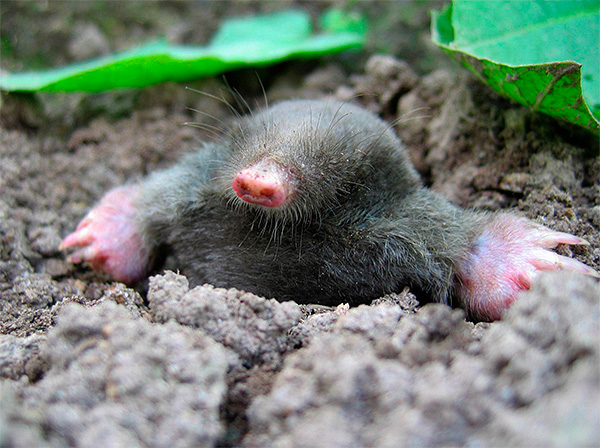

In fact, moles are not blind at all, they have eyes, and they use them successfully. In order to dispel some myths and misconceptions regarding the concept of mole blindness, let's take a closer look at these points.
Is the mole blind?
The photo below shows the head of an ordinary European mole:
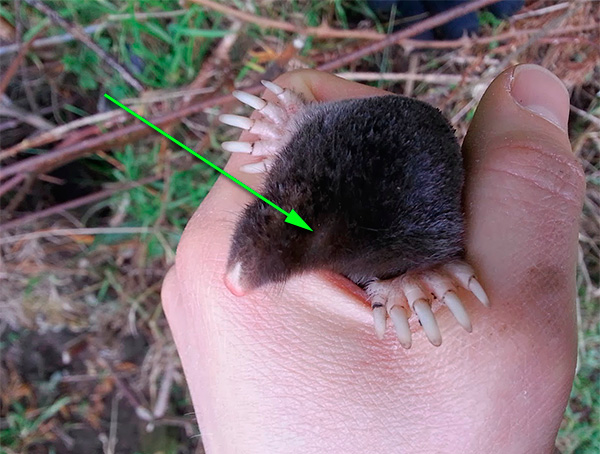
The spot indicated by the arrow is the eye of the animal. Moreover, this is a full-fledged eye that sees, albeit not as high quality, as a person has.
However, indeed, the eyesight of moles is generally relatively weak. They can:
- Distinguish primary colors;
- Distinguish between light and darkness;
- Register with your eyes the movement of objects;
- See large, prominent objects (for example, a large pile of land against a background of green grass).
At the same time, the mole is not able to distinguish, for example, a hidden predator (for example, a ferret) from a stone. He cannot see the worm lying motionless on the ground, but discovers it by smell and touch. Tactile abilities are especially developed in the so-called star-bearing moles, which have very sensitive mobile outgrowths in the nose.
Below is a photograph of a mole-bearer - this animal has a kind of additional "tactile" vision due to sensitive outgrowths, which quickly palpates the path in front of itself when moving:

Also, most species of moles do not see deleted objects. The radius of their vision is about 1-2 meters, and all that is further away is a blurred background.
Nevertheless, the presence of eyes and the ability to see them suggests that moles are not blind. Thus, the proverb “blind as a mole” is not entirely correct, although it is quite possible to understand why it appeared ...
Why are moles considered blind?
The opinion that the mole is blind appeared, obviously, from the testimonies of people who noticed him in the wild or caught on their sites.
Firstly, if the eyes of a mole are not purposefully sought, then they are not at all noticeable. The hair of the animal completely hides them, and nothing is visible on the head except the nose. At the same time, you should not expect that a summer resident or a gardener with an insult for spoiled beds will carefully poke around in the fur of an animal, looking for his eyes. One glance (unfortunately, often at a slaughtered animal) is enough to understand that the mole does not seem to have an eye at all, and therefore, the animal is blind.

On a note
Sometimes moles crawl out from under the earth to the surface, completely not noticing a person nearby. You can even bring a hand to the animal, but this will not scare him, and he will continue to fussyly search for insects in the grass. This once again testifies to the poor eyesight of moles and serves as an additional reason to call them blind.
Secondly, the question is quite logical: why, in fact, the mole's eyesight? After all, he spends most of his life underground, and comes to the surface only occasionally, more often - at night. The need for such luxuries as eyes, into which dust and earth can fall during underground work, is highly doubtful.
Nevertheless, the mole's eyes are still useful, but more on that later.
It should also be borne in mind that in some species of moles, the eyelids grow together, and the eyes literally remain under the skin. They have eyeballs, and even they see something, but there are no eyes on the surface of the body - why is there no reason to say that moles are blind?

In reality, moles can be considered blind only when their organs of vision, wherever they are, do not transmit any information to the brain. In most species of these animals, the eyes work for their intended purpose, as optical instruments, albeit very weak. Moreover, even being under the skin, they see, distinguish between light and darkness, and make the animal somewhat sighted.
It is interesting
Some species of moles are seen very well (for underground residents). For example, this family includes the long-tailed mole, whose vision is similar to that of shrews.
At the same time, the term “blind mole” itself, although not correct, is used in science. In science, there are many similar inaccuracies in general, and a separate mole is called a blind mole.
The blind mole as an independent species
The blind mole is called the small mole, Talpa caeca - the smallest representative of the family in Europe. Like an ordinary mole, he has eyes, but they are constantly under his skin and can only distinguish between light and darkness (there are also assumptions about the presence of color vision, although detailed studies that would confirm this have not been carried out).
In the photo - a blind mole:
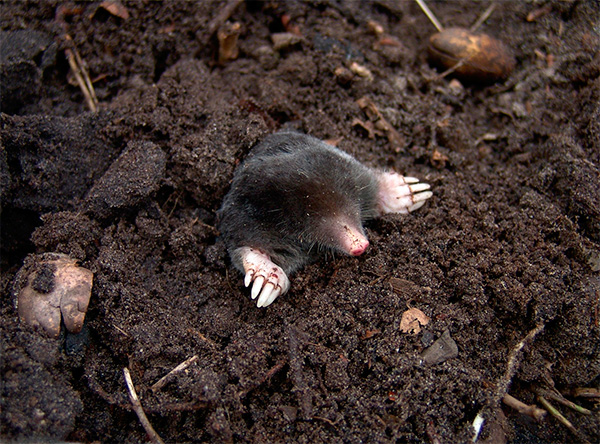
In general, this animal in its anatomy and biology is similar to its other relatives, having only a few pronounced and original differences:
- It is really small, rarely grows more than 12 cm in length (in an ordinary mole, the body length usually reaches 15-16 cm) and does not weigh more than 30 grams;
- This species has through holes in the collarbone, the origin and functions of which are still not clear;
- A blind mole mates in winter, even in frozen soil under snow, and its young are born in March, by the usual breeding season of other species, they become already completely independent individuals.
Talpa caeca lives mainly in southern Europe, in Italy and Greece, but does not occur in Russia. Previously, it was combined with the Caucasian mole in one species, but today it is considered an independent full-fledged systematic unit, and its habitat in the east is limited to Macedonia.

The blind mole prefers to settle in the foothills, on subalpine grassy meadows, is often found in the same habitats as the Caucasian mole, and can even use its moves to move and collect prey. In northern Greece, the range may intersect with the habitat of an ordinary, European mole.
The photo below shows heaps of land in a meadow thrown out of the course by a small mole:
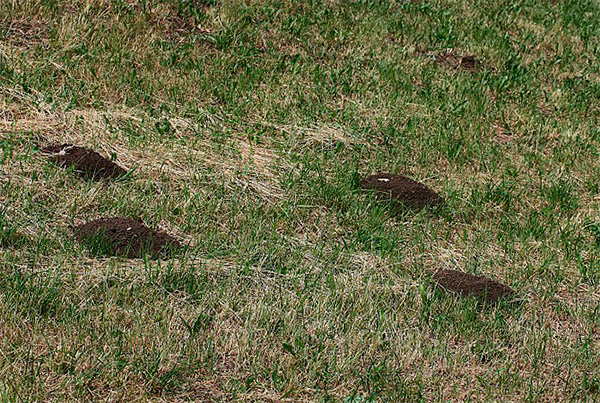
However, as you now understand, even a blind mole has eyes (even though they are located under the skin) and are able to see to some extent. This means that he is not so blind as he is called.
On a note
Science knows many such inaccuracies in animal names. For example, the gray rat in Latin is called Norwegian, since the scientist who described it met this rodent on Norwegian ships, although at that time these rats were not in Norway yet.
The American cockroach got its name because it entered Europe from the New World, although in America itself it turned out to be a guest from Africa.
So the blind mole was called blind, although the quality of his vision differs little from the sight of an ordinary, “not blind” cousin.
Can a mole live without sight?
Mole really uses his eyes constantly. Studies show that he:
- Seeks to escape from bright light - this allows him to constantly be under cover of the soil, and to appear on the surface mainly in the dark, when most of his enemies are sleeping;
- Notices a predator that has failed or deliberately climbed into the course, mainly due to the ability of the eyes to detect movement.And although in this situation the animal does not always manage to escape, often it is the discovery of a predator with the help of vision that allows it to stay alive. And such "sighted" individuals, participating in further reproduction and transferring their genes to offspring, inhibit the evolutionary degradation of vision;
- When exiting under the snow or on the surface of the soil, the animal can detect moving prey using its eyes.
That is, the sight of the mole is very helpful in his difficult life.

At the same time, under normal conditions, a mole can perform almost all the actions necessary for life without using its eyes. Collecting worms and insects in the passages, finding a sexual partner, laying new passages, raising offspring - all this does not require the use of vision, at least its absence is not critical for performing these operations. And even a completely blind mole will completely cope with these tasks.
Highly organized large eyes, providing sharp vision, in the conditions of regular underground work, would constantly clog, fester, lead to diseases and death. Perhaps this was what happened in the distant past, while moles adapted to underground life, and natural selection ruthlessly weed out those who had worse vision than required, but better than it was necessary for survival.

We conclude: the mole is capable of living without vision. But in many cases, it makes his life easier, and sometimes saves. That is, vision for the mole is like the ability to run fast for a person: to earn and build a career it usually does not help, but in dangerous situations it can be extremely useful ...
If not vision, then what?
The weakness of vision in moles is more than compensated by well-developed other sensory organs.
First of all, moles have a subtle scent. They find worms and insects by smell, when they enter a strange move, they immediately determine their age and employment, the sex of the owner and species. The smell also helps them in finding a sexual partner.
Secondly, the mole hears well. It is believed that the animal is able to hear human steps a few tens of meters from itself. Due to the unique structure of the inner ear, which is not found in any other mammals, the mole is very sensitive to low-frequency fluctuations and can feel the approach of earthquakes.
Thirdly, the nose of the mole has special sensitive areas with which the animal can touch the intended prey in order to study it. These areas are called Aimer's organs and are responsible for tactile sensations (like the feeling of touching a person’s finger with a finger, only much more sensitive).
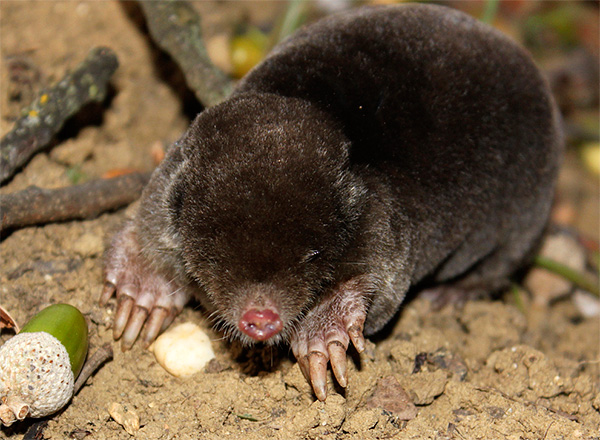
Particularly strongly, literally hypertrophied, these organs are developed in the mole-star -wing, turning in him into finger-shaped processes with which the animal literally feels everything around it. In the pitch darkness of the underground passage, such an organ is more functional than the eye that requires light.
Touching the earthworm with his nose, the animal immediately receives information about its temperature, humidity, surface topography, and ability to move. All this happens at a reflex level and at a tremendous speed - 8 milliseconds is enough for the animal to appreciate the edibility of what was under his nose.
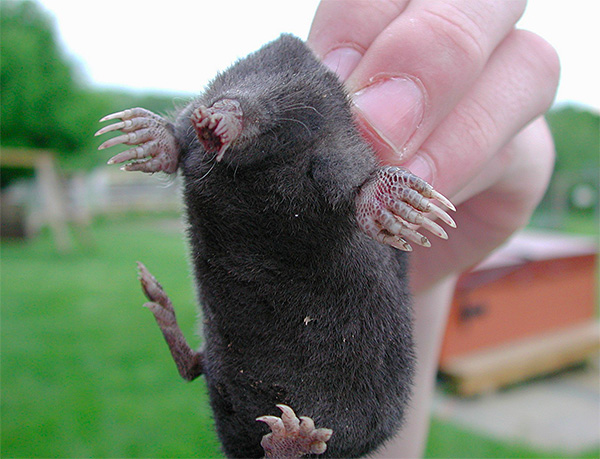

On a note
This specificity of the sense organs is widely used to combat moles in the gardens. Strongly smelling objects (kerosene-soaked rags, cigarette butts, naphthalene, vinegar) are laid in their burrows, which scare away the animals and sometimes poison them (for example, tear gas). Near the hole, ultrasonic repellers are installed, as well as objects that generate low or just loud sounds. With varying effectiveness, these tools scare off moles and make it easier to protect the site from them.
In general, the sense organs of moles are perfectly balanced and are suitable precisely for the lifestyle that these animals lead.And if they have eyes now, then they are still needed.
Other animals that lead a similar lifestyle, these organs are practically lost, and are really blind. For example, the Australian marsupial mole does not see anything at all, even without an optic nerve.
An interesting video: a blind mole cannot find a way home ...
An easy way to catch a mole in the garden




Very interesting. Thank.
Yes, the information is incredibly interesting.
Thank you for the article. I liked it very much.